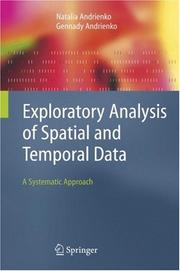| Listing 1 - 2 of 2 |
Sort by
|

ISBN: 3540259945 9783540259947 9786610608645 1280608641 3540311904 Year: 2006 Publisher: Berlin, Heidelberg : Springer Berlin Heidelberg : Imprint: Springer,
Abstract | Keywords | Export | Availability | Bookmark
 Loading...
Loading...Choose an application
- Reference Manager
- EndNote
- RefWorks (Direct export to RefWorks)
Exploratory data analysis (EDA) is about detecting and describing patterns, trends, and relations in data, motivated by certain purposes of investigation. As something relevant is detected in data, new questions arise, causing specific parts to be viewed in more detail. So EDA has a significant appeal: it involves hypothesis generation rather than mere hypothesis testing. The authors describe in detail and systemize approaches, techniques, and methods for exploring spatial and temporal data in particular. They start by developing a general view of data structures and characteristics and then build on top of this a general task typology, distinguishing between elementary and synoptic tasks. This typology is then applied to the description of existing approaches and technologies, resulting not just in recommendations for choosing methods but in a set of generic procedures for data exploration. Professionals practicing analysis will profit from tested solutions – illustrated in many examples – for reuse in the catalogue of techniques presented. Students and researchers will appreciate the detailed description and classification of exploration techniques, which are not limited to spatial data only. In addition, the general principles and approaches described will be useful for designers of new methods for EDA.
Temporal databases. --- Spatial analysis (Statistics) --- Multivariate analysis. --- Bases de données spatio-temporelles --- Analyse spatiale (Statistique) --- Analyse multivariée --- EPUB-LIV-FT LIVINFOR SPRINGER-B --- Computer science. --- Earth sciences. --- Information storage and retrieval. --- Application software. --- Geographical information systems. --- Computer Science. --- Computer Applications. --- Geographical Information Systems/Cartography. --- Earth Sciences, general. --- Information Storage and Retrieval. --- Information systems --- Multivariate distributions --- Multivariate statistical analysis --- Statistical analysis, Multivariate --- Analysis of variance --- Mathematical statistics --- Matrices --- Analysis, Spatial (Statistics) --- Correlation (Statistics) --- Spatial systems --- Temporal data bases --- Databases --- Spatial analysis (Statistics). --- Geography. --- Information storage and retrieva. --- Information retrieval. --- Informatics --- Science --- Cosmography --- Earth sciences --- World history --- Geographical information systems --- GIS (Information systems) --- Information storage and retrieval systems --- Data retrieval --- Data storage --- Discovery, Information --- Information discovery --- Information storage and retrieval --- Retrieval of information --- Documentation --- Information science --- Geography --- Information storage and retrieval systems. --- Automatic data storage --- Automatic information retrieval --- Automation in documentation --- Computer-based information systems --- Data processing systems --- Data storage and retrieval systems --- Discovery systems, Information --- Information discovery systems --- Information processing systems --- Information retrieval systems --- Machine data storage and retrieval --- Mechanized information storage and retrieval systems --- Computer systems --- Electronic information resources --- Data libraries --- Digital libraries --- Information organization --- Information retrieval --- Geosciences --- Environmental sciences --- Physical sciences --- Application computer programs --- Application computer software --- Applications software --- Apps (Computer software) --- Computer software
Digital
ISBN: 9783642375835 9783642375828 9783662507285 Year: 2013 Publisher: Berlin Springer
Abstract | Keywords | Export | Availability | Bookmark
 Loading...
Loading...Choose an application
- Reference Manager
- EndNote
- RefWorks (Direct export to RefWorks)
Many important planning decisions in society and business depend on proper knowledge and a correct understanding of movement, be it in transportation, logistics, biology, or the life sciences. Today the widespread use of mobile phones and technologies like GPS and RFID provides an immense amount of data on location and movement. What is needed are new methods of visualization and algorithmic data analysis that are tightly integrated and complement each other to allow end-users and analysts to extract useful knowledge from these extremely large data volumes. This is exactly the topic of this book. As the authors show, modern visual analytics techniques are ready to tackle the enormous challenges brought about by movement data, and the technology and software needed to exploit them are available today. The authors start by illustrating the different kinds of data available to describe movement, from individual trajectories of single objects to multiple trajectories of many objects, and then proceed to detail a conceptual framework, which provides the basis for a fundamental understanding of movement data. With this basis, they move on to more practical and technical aspects, focusing on how to transform movement data to make it more useful, and on the infrastructure necessary for performing visual analytics in practice. In so doing they demonstrate that visual analytics of movement data can yield exciting insights into the behavior of moving persons and objects, but can also lead to an understanding of the events that transpire when things move. Throughout the book, they use sample applications from various domains and illustrate the examples with graphical depictions of both the interactive displays and the analysis results. In summary, readers will benefit from this detailed description of the state of the art in visual analytics in various ways. Researchers will appreciate the scientific precision involved, software technologists will find essential information on algorithms and systems, and practitioners will profit from readily accessible examples with detailed illustrations for practical purposes.
Mathematical statistics --- Geodesy. Cartography --- Office management --- Computer science --- Information systems --- Artificial intelligence. Robotics. Simulation. Graphics --- Computer. Automation --- Geography --- patroonherkenning --- geodesie --- factoranalyse --- GIS (geografisch informatiesysteem) --- RFID (radio frequentiële identificatie) --- computers --- informatica --- bedrijfsadministratie --- informatiesystemen --- database management --- computerkunde --- data acquisition --- optica
| Listing 1 - 2 of 2 |
Sort by
|

 Search
Search Feedback
Feedback About
About Help
Help News
News